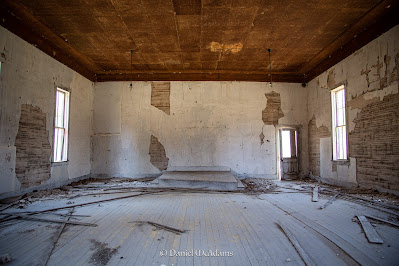While researching old, historic and abandoned churches in Missouri, I came across a photo and post on Looney's Creek Old School Baptist Church. The name immediately caught my attention. In my opinion, that has to be one of the most unique and cool names for a church that I have yet come across (though Bacon Chapel, which I will be writing about in a future post, is probably the coolest church name I've yet seen).
Looney's Creek Old School Baptist Church has its beginnings very early on in Missouri history. Originally founded as Looney's Creek Mt. Zion Church, it formed out of the membership of the Baptist
Church at Pleasant Hill in Marion County, Missouri, on 14 May 1836 and met in the home of Caroline Looney on Looney Creek. Robert Hendren and Charles L. Turner were elected church elders. A log meeting house was erected in 1837 and Henry Louthan became the pastor at the at time. Louthan opposed the "Mission System" and the church became divided. Louthan and his followers split off and formed Henry Louthan Baptist Church (which would later be called Looney's Creek Old School Baptist Church) and the other church continued on as Looney's Creek Mt. Zion Church. Louthan pastored Looney's Creek for 34 years and was known as the man "who preached without charge and labored with untiring energy." F. M. Turner took over as pastor after Louthan. The church was organized before the Baptist split into two factions, the Old School and the New School.
Looney's Creek Old School Baptist Church was still in active in 1938.
Throughout its existence, the church has been known by many names including: Primitive Baptist Church, Hardshell Baptist, Old School Baptist. (Interesting note concerning the name "Old School", within Baptist circles there were churches that stressed being "old school" or "new school" in response to the First Great Awakening in the 18th century. In Presbyterian circles they were called "Old Path" or "New Path". The old school/path churches opposed the revivalism and new fads that grew out of the First Great Awakening and stressed a simple, more traditional and conservative approach to church services and Christian life. New school/path churches embraced revivalism and the new trends (including Sunday School, missions societies, experiential services) and adapted their church services and life to include such.
The Old School Baptist denomination used to be quite prominent in northern Missouri. It is now currently known as Primitive Baptists and the denomination as a whole is much smaller and nowhere near as prominent as it used to be. The name "primitive" simply means that the church or denomination sought to mirror as closely as possible how the church is described in the New Testament of the Bible. No alter calls, no fancy "concert-like" musical service, etc, but rather the simple style of church service as seen in the Bible itself.
In typical Baptist fashion, the church building is a simple, unadorned structure. It is a wooden frame, single-room building with a gable style roof. Inside there is a small, slightly raised platform at the front of the building for the preacher. There is a door on the back and the main two doors on the front of the building. There is also a graveyard associated with this church.











No comments:
Post a Comment